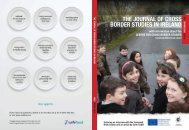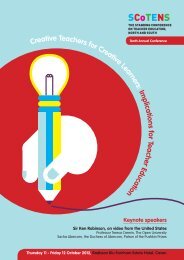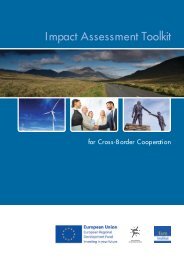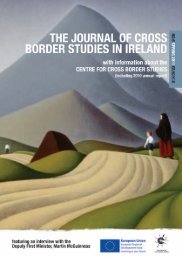improving government service delivery to minority ethnic ... - NCCRI
improving government service delivery to minority ethnic ... - NCCRI
improving government service delivery to minority ethnic ... - NCCRI
You also want an ePaper? Increase the reach of your titles
YUMPU automatically turns print PDFs into web optimized ePapers that Google loves.
<strong>improving</strong><br />
<strong>government</strong><br />
<strong>service</strong><br />
<strong>delivery</strong><br />
<strong>to</strong> <strong>minority</strong><br />
<strong>ethnic</strong> groups<br />
Chapter 1: Context 32_33<br />
50_www.immi.gov.au/<br />
living-in-australia/<br />
help-with-english/<br />
help_with_translating/<br />
english-speakers/index.htm<br />
51_European Commission<br />
Direc<strong>to</strong>rate-General Justice,<br />
Freedom and Security<br />
(2004), Handbook on<br />
Integration for policymakers<br />
and practitioners.<br />
Shortcomings of this particular Policy Framework include the lack of funding available for <strong>government</strong><br />
departments seeking <strong>to</strong> implement the Policy Framework and <strong>to</strong> undertake specific initiatives. This kind of<br />
approach whereby Government departments must be proactive is seen as a much more effective mechanism<br />
for ensuring equality than the traditional approach employed by the Equal Opportunity Commission in Western<br />
Australia and similar bodies in other countries, which are primarily set up <strong>to</strong> accept and mediate complaints of<br />
discrimination. One of the drawbacks of this approach is that it cannot address systemic issues.<br />
Developments in the UK, including the work of the Commission for Racial Equality and the findings of the<br />
MacPherson Report were instrumental in the development of the Australian model; although as with all<br />
strategies, it had <strong>to</strong> be adapted <strong>to</strong> suit the local context. The Policy Framework was also introduced in<strong>to</strong><br />
an environment very experienced in dealing with <strong>ethnic</strong> diversity. The following are some examples of the<br />
framework already in place <strong>to</strong> support <strong>minority</strong> <strong>ethnic</strong> communities, including the Indigenous Aboriginal<br />
peoples:<br />
-<br />
-<br />
-<br />
-<br />
There is a dedicated Federal Department of Immigration and Multicultural and Indigenous Affairs<br />
In Western Australia there is a dedicated State Department Office of Multicultural Interests and Department<br />
of Indigenous Affairs<br />
There is an Australian wide Government interpreting and translating <strong>service</strong> 50<br />
A number of guides and <strong>to</strong>ols already exist, such as a guide on community consultation, guides on data<br />
collection and so forth.<br />
The European Commission published a handbook of good practice on integration – Handbook on Integration<br />
for policy-makers and practitioners in November 2004. 51 Although the focus tends <strong>to</strong> be on recent migrants and<br />
thus other <strong>minority</strong> <strong>ethnic</strong> groups, including longstanding <strong>minority</strong> <strong>ethnic</strong> groups and indigenous groups such<br />
as Travellers, are excluded, it nonetheless provides a useful summary of best practice throughout Europe at<br />
least in relation <strong>to</strong> recent migrants. The handbook is divided in<strong>to</strong> three chapters: introduction of newly arrived<br />
immigrants and recognised refugees, civic participation, and indica<strong>to</strong>rs.<br />
One of the drawbacks of the handbook is its emphasis on “access and accessibility” of <strong>service</strong>s. However,<br />
it is widely recognised that access <strong>to</strong> a <strong>service</strong> is just one of a number of barriers and that the entire <strong>service</strong><br />
needs <strong>to</strong> be assessed for participation rates, satisfaction rates and outcomes for various groups. The European<br />
handbook provides useful discussion and recommendations on the selection and use of indica<strong>to</strong>rs. However,<br />
this is based on the assumption that <strong>government</strong>s have appropriate data collection. Indica<strong>to</strong>rs will be discussed<br />
later under the heading of ‘benchmarking’.<br />
The handbook offers a list of practical, succinct conclusions and recommendations at the end of each chapter.<br />
It suggests the use of dynamic ways of assessing the skills of newcomers, relying less on formal criteria<br />
and valuing different kinds of experience. It also suggests that <strong>government</strong>s engage with the private sec<strong>to</strong>r<br />
in relation <strong>to</strong> migrants by linking <strong>government</strong>al programmes with companies’ corporate social responsibility<br />
programmes. For example, in Cyprus, all arrangements for the reception (including housing) of temporary labour<br />
migrants are carried out by or with the assistance of employers and in the case of breach of these obligations,<br />
the employers are penalised and no further work permits are granted <strong>to</strong> them.<br />
The need <strong>to</strong> closely cooperate with migrants’ associations and NGOs is stressed in the handbook and it<br />
is recognised that these bodies often play an essential role in <strong>service</strong> provision. It also recommends having<br />
individuals from <strong>minority</strong> <strong>ethnic</strong> groups on boards and committees <strong>to</strong> help bring a broad range of views <strong>to</strong> bear<br />
on all key decisions.
















